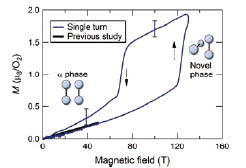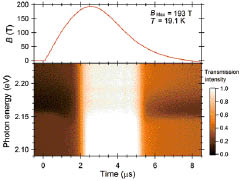Discovery of Novel Phase of Solid Oxygen in Ultrahigh Magnetic Fields
T. C. Kobayashi and Y. H. Matsuda
Molecular oxygen has the spin S = 1 and the relation between the magnetic interaction and the crystal structure has been attracting attention of material scientists for a long time [1]. In the present work, we discovered a novel phase of solid oxygen as a result of the first-order structural phase transition by applying an extraordinarily strong magnetic field of up to 193 Tesla [2]. The change in the crystal symmetry due to the rearrangement of O2 molecules is strongly suggested, which can make the new oxygen phase ferromagnetic. Since all known seven phases of solid oxygen have the antiferromagnetic nature, it is remarkable to obtain ferromagnetic oxygen.

Fig. 1. The magnetization curve in α-oxygen at 9 K up to 129 T.

Fig. 2. (a) The waveform of the pulsed magnetic field. (b) The two-dimensional magneto-transmission image of α-oxygen.
The magnetization and magneto-transmission measurements have been performed in ultrahigh fields using a destructive manner, the single-turn coil technique. The magnetic field was applied in the α-phase of solid oxygen at low temperatures (T < 24 K). As shown in Fig. 1, we found that the magnetization rapidly increased at around 125 T. This is a clear evidence of the field-induced magnetic phase transition. Since the magnetization process has the large hysteresis, the transition is expected to be of first order. Figure 2 shows the time dependence of the magnetic field and two-dimensional magneto-transmission image. You can see that something drastic happens at very high magnetic fields. The field where this phenomenon is seen almost corresponds to the critical field of the magnetization jump shown in Fig. 1.
The structural phase transition along with the magnetic transition explains the experimental findings; the significant increase of the light transmission is due to the reduction of the classical light scattering at the domain boundaries. In the strong magnetic field, the crystal structure becomes isotropic (cubic) from the anisotropic one (monoclinic). The origin of the phase transition is suggested to be the rearrangement of O2 molecules, which is driven by the change in the exchange interaction depending on the spatial arrangement of the O2 molecules.
The discovered novel phase is the eighth phase of solid oxygen, which has the different geometry of O2 molecules from other seven phases. The state-of-the-art high magnetic field technique was essential in this discovery. Nowadays, in materials science, many treasures waiting for discovery are expected at the frontier of extreme high field.
References
- [1] Y. A. Freiman, and H. J. Jodl, Phys. Rep. 401, 1 (2004) and references therein.
- [2] T. Nomura, Y. H. Matsuda, S. Takeyama, A. Matsuo, K. Kindo, J. L. Her, and T. C. Kobayashi, Phys. Rev. Lett., Editors’ Suggestion, (2014) in press.
